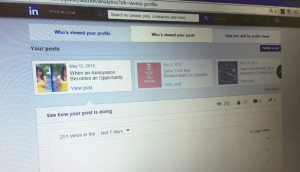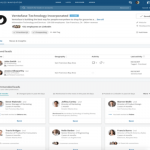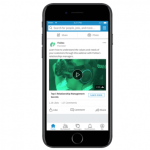benefit from “Who’s seen Your Posts” on LinkedIn
could 26, 2015
 one of the crucial best options rolled out by means of LinkedIn as of late—one who’s been on my LinkedIn want list, too—is the “Who’s seen Your Posts” for printed articles. “Who’s considered Your Posts” is an easy, yet powerful analytics platform that tracks the the long-type content printed on LinkedIn.
one of the crucial best options rolled out by means of LinkedIn as of late—one who’s been on my LinkedIn want list, too—is the “Who’s seen Your Posts” for printed articles. “Who’s considered Your Posts” is an easy, yet powerful analytics platform that tracks the the long-type content printed on LinkedIn.
So… what’s the large care for Who’s viewed Your Posts? As LinkedIn Product supervisor Angela Yang says:
Analytics for publishing on LinkedIn provides insights into who’s reading and fascinating with your posts. With this information, you’ll be able to assessment whether or not you’re reaching the correct audience, which posts are resonating with readers, and more.
This new feature will also be reached by way of Profile > Who’s viewed Your Profile > Who’s considered Your Posts. (Don’t be anxious if you happen to don’t but see it to your account. this option is in a phased roll-out to all customers, so it’ll be there at some point.)
What “Who’s seen Your Posts” gives
should you’re used to the granularity of a Google Analytics-type of platform, you’ll be dissatisfied. the data tracked and presented here is lovely general, yet there’s enough to offer you some excellent knowledge, including:
- total choice of views per day over several time sessions, from last seven days to remaining six months
- Very general demographic details about your readers (trade, job titles, vicinity and incoming visitors sources)
- The collection of “likes,” feedback and shares of your put up, and who did each (except for for shares, where those with safe profile views and those outside your network are hidden)
(need more details, and the wider implications from this information? here’s the LinkedIn put up on the LinkedIn Who’s considered Your Posts platform.)
I see a somewhat different good thing about this new characteristic:
reach Out to potential Connections
I liken one of the data from “Who’s considered Your Posts” to the “Caller identity” side of LinkedIn I’ve mentioned in prior articles—higher known as the Who’s viewed Your Profile characteristic. With “Caller id,” you will discover who used to be sufficient in you to click over to your profile (provided they have got their profiles set so one can find who they’re).
Like “Caller identification,” the individuals who like, remark or share your content material are thinking about what it’s a must to say, and in what you do for a residing. In my ebook, that’s gold.
not like “Caller identity,” on every occasion someone likes or comments on your content, you’ll have the ability to see who they are. this is enormous! With this information, that you can interact these folks and notice if they’re prepared to turn into a 1st-stage connection of yours. I’ve achieved this in the past; while I haven’t saved explicit records, I’d guess the percent of these accepting my requests at about 60%.
(The identities of those who share your content material, however have their profiles protected or are outdoor of your community, are nonetheless hidden in this new platform.)
here’s How…
i have one template for every of the aforementioned teams. while all three are similar, they’re simply totally different enough to warrant being listed one after the other. They’re additionally beautiful easy to customise, relying on your particular state of affairs. here’s my template for shares:
[NAME], thanks for sharing my article, [subject or title]. I take pleasure in your spreading the phrase on it. as a result of we’ve got a mutual interest in [subject], I’d like to connect here and discover ways we may be able to work together. i hope you agree.
~ Bob Woods
… for commenters:
[NAME], thanks for commenting on my article, [subject or title]. I appreciate your comment, and have already answered to yours. seeing that we’ve got a mutual pastime in [subject], I’d like to connect right here and explore methods we might be able to work collectively. i hope you agree.
~ Bob Woods
… and for likes:
[NAME]: Thanks for “liking” my latest article, [subject or title]; I have fun with it. because we share an hobby in [subject], i believe we will have to join right here and explore methods we might be able to work together. i’m hoping you settle. Thanks!
~ Bob Woods
you might have a greater chance of connecting with folks who share your content material and with commenters than “likers,” as a result of those within the first two teams cared enough about what you wrote to take the additional time voice an opinion on it or share it. but don’t cut price that latter staff!
it doesn’t matter what, although, always point out your article’s title or subject for your connection request. in the case of a comment, make sure to point out that you just’ve responded to their comment—you’re replying to all of your commenters, proper?—and that you have fun with theirs. consider, although, that you’ve got a limited collection of characters in that request, so make each letter depend.
As you can more than likely tell, I’m very excited that i will be able to tick this selection off of my LinkedIn want record. subsequent item up for bids on my record? the same performance for standing updates. imagine what will be done with that!
Digital & Social Articles on industry 2 group
(119)













